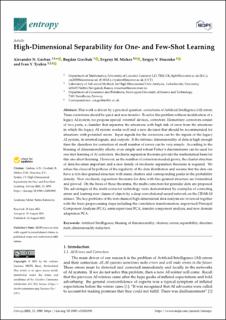| dc.description.abstract | This work is driven by a practical question: corrections of Artificial Intelligence (AI) errors. These corrections should be quick and non-iterative. To solve this problem without modification of a legacy AI system, we propose special ‘external’ devices, correctors. Elementary correctors consist of two parts, a classifier that separates the situations with high risk of error from the situations in which the legacy AI system works well and a new decision that should be recommended for situations with potential errors. Input signals for the correctors can be the inputs of the legacy AI system, its internal signals, and outputs. If the intrinsic dimensionality of data is high enough then the classifiers for correction of small number of errors can be very simple. According to the blessing of dimensionality effects, even simple and robust Fisher’s discriminants can be used for one-shot learning of AI correctors. Stochastic separation theorems provide the mathematical basis for this one-short learning. However, as the number of correctors needed grows, the cluster structure of data becomes important and a new family of stochastic separation theorems is required. We refuse the classical hypothesis of the regularity of the data distribution and assume that the data can have a rich fine-grained structure with many clusters and corresponding peaks in the probability density. New stochastic separation theorems for data with fine-grained structure are formulated and proved. On the basis of these theorems, the multi-correctors for granular data are proposed. The advantages of the multi-corrector technology were demonstrated by examples of correcting errors and learning new classes of objects by a deep convolutional neural network on the CIFAR-10 dataset. The key problems of the non-classical high-dimensional data analysis are reviewed together with the basic preprocessing steps including the correlation transformation, supervised Principal Component Analysis (PCA), semi-supervised PCA, transfer component analysis, and new domain adaptation PCA. | en_US |

